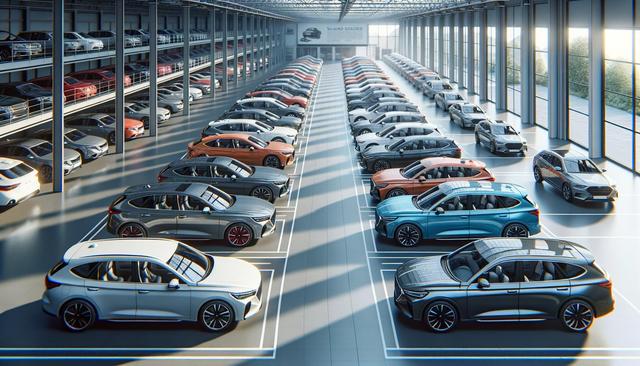Introduction to Unsold Cars
Every year, automakers produce millions of vehicles to meet anticipated consumer demand. However, not all of these cars end up in the hands of buyers. This leads to an accumulation of unsold cars, which poses economic and logistical challenges for manufacturers, dealerships, and even consumers. Understanding the dynamics of unsold inventory is crucial for anyone interested in the automotive sector. The issue is not just about overproduction, but also about shifting trends, evolving technologies, and changing consumer behaviors. This Introduction to Unsold Cars helps set the stage for exploring the deeper causes and potential solutions related to this phenomenon.
Unsold vehicles are typically stored in large lots, sometimes out of public view. These cars may remain there for months or even years, depreciating in value. While some are eventually sold at discounted rates or used as fleet vehicles, others may be scrapped or repurposed. The presence of unsold stock affects pricing, dealer incentives, and even future production planning. As such, it is not merely a supply chain issue but a broader market concern.
Causes of Unsold Cars
Several factors contribute to the growing number of unsold cars. These include misjudged market demand, economic downturns, and rapid shifts in consumer preferences. In many cases, manufacturers overestimate how many units a particular model will sell, leading to excess inventory. This mismatch between supply and demand is one of the primary Causes of Unsold Cars.
Here are some common reasons cars remain unsold:
- Market saturation: When too many similar vehicles are available, competition increases and vehicles can sit unsold.
- Technological obsolescence: Rapid advancements in automotive technology mean older models lose appeal quickly.
- Change in consumer trends: A growing preference for electric vehicles (EVs) or SUVs can leave sedans and older combustion models behind.
- Economic factors: Recessions or job uncertainty can reduce consumer spending and lower car sales.
In addition, regulatory changes and environmental standards can also render certain models undesirable or even non-compliant in specific regions. All these aspects combine to explain why unsold cars accumulate across global markets.
Unsold Cars 2015-2023
The period from 2015 to 2023 has seen notable fluctuations in unsold car inventories. This timeline includes both economic optimism and significant downturns, such as the global impact of the COVID-19 pandemic. The automotive industry faced unique challenges during these years that contributed to the rise and fall of unsold vehicle numbers. Examining Unsold Cars 2015-2023 provides valuable insight into the broader economic and industrial context.
Some key observations from this period include:
- 2015-2017: A steady rise in vehicle production coincided with moderate sales growth, leading to manageable levels of unsold inventory.
- 2018-2019: Increased competition and shifting preferences toward EVs began to create excess stock in traditional vehicle segments.
- 2020: The pandemic led to factory shutdowns and reduced consumer activity, causing a temporary dip in production but also a rise in unsold pre-pandemic models.
- 2021-2023: Supply chain issues, including chip shortages, slowed production, but demand remained unpredictable, leading to uneven inventory distribution.
The period also saw a growing awareness among manufacturers of the need to adapt production to real-time market data. However, the lag in implementing these changes meant that unsold cars still accumulated in large numbers throughout these years.
Solutions to Address Unsold Cars
Automakers and dealerships have developed various strategies to manage and reduce the number of unsold vehicles. These Solutions to Address Unsold Cars include both preventative measures and reactive tactics aimed at minimizing losses and improving inventory turnover. The effectiveness of these solutions often depends on how quickly companies can adapt to market signals and consumer behavior.
Common strategies include:
- Dynamic production planning: Using data analytics to align manufacturing with real-time demand.
- Incentive programs: Offering discounts, trade-in bonuses, or financing options to stimulate purchases of older inventory.
- Exporting vehicles: Selling excess stock in markets where demand still exists for those specific models.
- Fleet sales: Providing unsold cars to rental companies, government agencies, or corporate fleets at bulk rates.
- Vehicle repurposing: Converting unsold combustion engine vehicles for alternative uses, such as hybrid retrofitting or parts recovery.
In addition to these strategies, some companies are investing in better forecasting tools and AI-driven platforms that help predict demand more accurately. The goal is to avoid the costly outcome of overproduction while remaining agile in a changing market landscape.
The Future Outlook and Industry Adaptation
Looking ahead, the automotive industry is likely to become more responsive and data-driven to prevent the recurrence of large inventories of unsold vehicles. The emergence of electric vehicles, connectivity technologies, and subscription models may also reshape how cars are produced, sold, and owned. This shift encourages manufacturers to adopt just-in-time production and more flexible sales models, reducing dependence on large dealer inventories.
The issue of unsold cars also emphasizes the need for sustainability in automotive manufacturing. Excess inventory contributes to waste, both in terms of resources and emissions generated during production. Addressing this challenge is part of a broader effort to make the industry more environmentally responsible and economically efficient.
Consumer education plays a role as well. Buyers who understand the value of previous model-year vehicles—often sold at a discount—can help reduce unsold inventory while benefiting from lower prices on reliable cars. Transparency in pricing and better marketing of older models can turn unsold stock into opportunities for both businesses and customers.
As the industry continues to evolve, the lessons learned from the challenges of Unsold Cars 2015-2023 and the implementation of effective Solutions to Address Unsold Cars will be critical in shaping a more resilient automotive sector.






